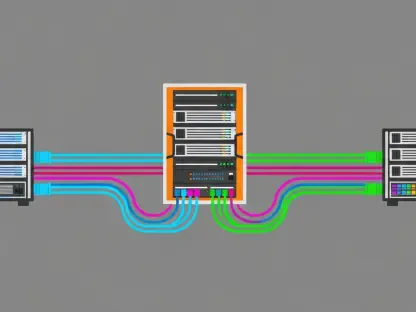In a world where data is increasingly dominant, industries look to leaders like Formula 1 for transformative insights that leverage data to their advantage. Formula 1, often perceived merely as a high-speed, adrenaline-pumping sport, actually stands as a pinnacle of digital sophistication. The sport’s evolution into a data powerhouse provides telecom companies a rich repository of strategies, especially in dealing with OSS/BSS modernization and operational agility. This parallel draws attention to how Formula 1’s seamless use of real-time data streams acts as a foundational guideline for telecom companies aspiring to effectively harness data in their intricate landscapes.
Real-Time Data Mastery in Formula 1
Formula 1’s expertise in harnessing real-time data sits at the heart of its competitive strategy. Every car in a race acts as a relentless data generator, emitting substantial telemetry data each lap. This data is processed both trackside and remotely, emphasizing the importance of split-second analysis that characterizes their strategic decisions. Such prowess in data management resonates with telecom operators, who manage expansive, intricate systems that demand immediate responses. Unlike the historic reactive measures, telecoms are now encouraged to pivot towards predictive analytics—enabling them to foresee challenges and capitalize on emerging opportunities through real-time insights and data-driven decision-making.
The significance of streamlining operations through real-time data is prevalent in global events akin to the Olympics and World Cup, where vast streams of information are analyzed in an instant. Formula 1 mirrors this caliber of operations, positioning itself not just as a competitor but a forerunner in data mastery. This ideology transcends into the telecommunications sphere, where embracing a model of proactive vigilance over passive observation can dramatically refine a company’s agility. By adopting a model reminiscent of Formula 1’s, telecoms can transition their OSS/BSS systems to be attuned with the future, offering responses that are not only swift but also strategically informed.
Safety Innovations Through Data
The transformation in Formula 1’s safety measures over recent years serves as an enlightening case study in leveraging data for impactful outcomes. Historically, an era of frequent tragedies in the motorsport world fueled the sport to evolve, embracing digital innovations to predict and prevent potential hazards. By converting historical data pools into predictive safety models, Formula 1 revolutionized its protocol, markedly reducing driver fatalities over the subsequent decades. This paradigm shift in Formula 1 offers telecoms lessons in not just gathering vast data, but in transforming that data into actionable insights focused on augmenting customer experience, thwarting pervasive fraud, and enhancing network resilience.
The notion of data repurposing finds fertile ground in the telecommunications sector. Telecoms, much like Formula 1, command an abundance of data capable of reshaping existing frameworks into more robust and resilient systems. By projecting a proactive stance on safety, using predictive analytics, telecoms could foresee and mitigate risks, fundamentally altering customer safety and satisfaction landscapes. The journey of Formula 1 from a devastating past to a near flawless safety record epitomizes the transformative power of data when applied judiciously and strategically—something the telecom industry must heed to fortify its future operational paradigms.
Efficiency in Operations: Lessons from Pit Stops
One of the most intriguing aspects of Formula 1’s display of efficiency unfolds in its pit-stop orchestration, where 36 precise operations happen in less than two seconds. This feat is not merely about speed; it’s a testament to meticulous planning and execution. Even a minor deviation in parking can slow down operations by valuable fractions of a second, which is a lesson in the emphasis on precise alignment. This principle holds profound relevance for telecoms, demonstrating that operational efficiency can be tremendously improved by sticking to simplified processes and squeezing inefficiencies out of existing systems rather than adding unnecessary layers of complexity.
Operational agility within Formula 1 is achieved through keen insight into complex systems, ensuring no operation exists without purpose and that all are executed with precision. This transfers to the telecom landscape, instructing operators to refine routine operations through strategic enhancements. As telecoms undertake the modernization of legacy systems, adhering to this fine balance between simplicity and innovation can optimize processes and recover valuable time and resources. The lessons drawn from Formula 1 are clear: lean management principles, driven by data insights, are essential in accessing new efficiency levels without overhauling robust, functional structures unnecessarily.
The Role of Digital Twins and AI
The sophisticated use of digital twins and AI has been pivotal in Formula 1’s strategy, epitomizing a “code before steel” philosophy. By executing simulations before actual physical tests, Formula 1 saves significant time and resources, while fostering unparalleled innovation cycles. This approach can greatly benefit telecoms, which can employ digital twins for testing customer journey simulations or stress-testing new billing logics before actual deployment, thus ensuring unparalleled accuracy and reliability. The integration of AI in decision-making also holds immense promise, suggesting transformative avenues for automating and streamlining regulatory compliance.
In this context, Apex by PaceTech emerges as an exemplar, functioning as a virtual race director that informs decisions using rules, sensory data, and video input. Such systems ensure coherent, AI-guided strategies conducive to accurate and consistent decision-making. For telecoms, imitating this AI-powered blueprint offers a roadmap for refining critical operational aspects. By maintaining commercial awareness while augmenting insights through AI, telecoms can foster robust innovation without relinquishing strategic control, ultimately enhancing efficiency, reducing overheads, and carving a future-proof position within the global market landscape.
Embracing Data-Driven Transformation
Formula 1’s metamorphosis into a data-centric organization encapsulates a journey that telecom companies can emulate to maintain their competitive edge. From serving as a simple engineering prototype hub, the sport has transitioned into an entity where data not only informs strategies but shapes outcomes. This seamless transformation emphasizes a broader narrative applicable to telecoms: the urgent need for OSS/BSS system renewal built upon the premise of treating data as an invaluable asset. Being able to anticipate customer needs, optimize network integrity, and enhance service delivery hinges significantly on adopting a proactive, well-informed approach to data-driven operations.
For telecoms, mirroring this approach means investing in robust data systems capable of supporting advanced analytics and adaptable infrastructures that prioritize agility and efficiency. Embracing digital transformation rooted in the blueprint of Formula 1 offers a strategic advantage, turning insights into action, and ultimately leading to heightened operational efficiencies and customer satisfaction. By understanding the integral role data plays in modern businesses, telecom operators are prepared to propel themselves toward a future where innovation is limitless, and connectivity is ubiquitous.
Shaping the Future with Formula 1’s Blueprint
In today’s increasingly data-driven world, industries are in search of pioneering leaders like Formula 1 that provide transformative insights, utilizing data effectively to gain a competitive edge. While many might view Formula 1 merely as a thrilling, high-speed sport, it actually epitomizes digital sophistication at its finest. Its transformation into a data powerhouse offers telecom companies a rich source of strategies, particularly in addressing OSS/BSS modernization and achieving operational agility. This analogy highlights how Formula 1’s adept use of real-time data streams sets a foundational guideline for telecom firms eager to optimize data within their complex frameworks. The sport’s mastery of digital technologies serves as a model of innovation, revealing how harnessing data strategically can drive performance and foster advancements. Telecom companies can emulate this approach to improve decision-making, refine customer experiences, and navigate the future’s technological challenges.









